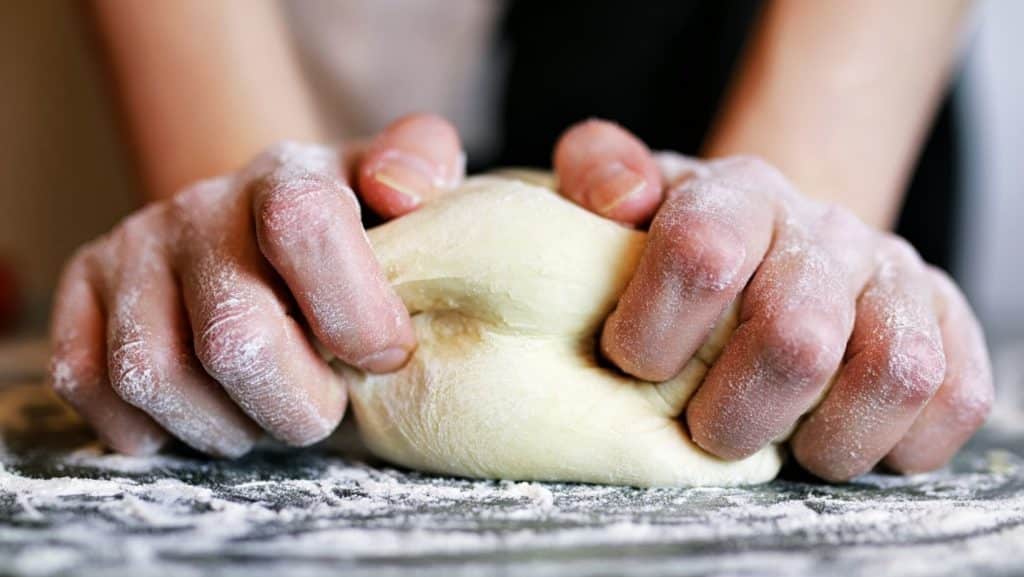
Is this sounding familiar: tight, dry, and hard pizza dough that won’t stretch? We’ve all encountered it at some point.
So I spent some time researching what makes pizza dough stretchy. Here’s what I discovered – the key to easily stretchy pizza dough.
The most common reason for a pizza dough’s lack of stretchiness is a lack of gluten development, with the gluten strands being too tight as a result of insufficient relaxation time, you’re using the wrong type of flour, the dough is too dry, or the dough is too cold.
- If you use the wrong flour,
- The amount of kneading (over and under development of gluten)
- The dough isn’t yet relaxed enough.
- Dough too dry
- Dough is too cold
Its The Gluten That Is The Problem
Dough that isn’t stretchy is often caused by gluten.
Gluten is a set of proteins found in wheat flour that binds the dough together. When you add water and knead the dough, the gluten in the flour develops a network.
The more you knead the dough, the stronger this network becomes. The development of gluten over time is aided by hydration as well.
So, even without kneading, the gluten will grow for long, slow fermentation.
The gluten network begins to develop and grow as you knead the dough. When this happens, the dough becomes very elastic and difficult to stretch.
The dough will just rip if you try to extend it if it develops too much. The important thing is to have just the right amount of gluten development.
The three reasons for wanting the gluten network to grow are:
- Give the dough structure
- Trap gas from the fermentation
- Make the dough together
If the dough has not developed enough gluten, it will puncture during fermentation and be unable to retain CO2 produced by the yeast.
Without forming holes in the pizza, the dough will be difficult to stretch and launch into the oven.
The amount of gluten in the flour, how much you knead the dough, and how long it’s left to rise are all important factors that impact the strength or weakness of the gluten network.
So you’ll need to choose a flour with the right amount first.
But there’s more to the gluten network’s stronger than that.
The gluten strands become tense when you knead the dough. The dough is easier to stretch when the gluten is tense.
However, if you wait for the dough to rest, the gluten will relax and the dough will be more flexible.
You want a tough gluten network that prevents tearing while also allowing the gluten to relax, resulting in a dough that is soft pliable and easy to stretch.
What Makes Pizza Dough not Stretchy?
The balance between gluten development and the dough’s flexibility are the most important factors in how stretchy it is.
It’s down to the flour
To make an excellent pizza, you must begin with high-quality flour. The ideal gluten formation starts with flour with the proper gluten level.
The ideal amount of gluten is 10-13%. You’ll get a weak dough that won’t hold up during proofing if you use cake flour, which has a low level of gluten.
If you’re using bread flour, on the other hand, it’s high in gluten, so you’ll get a dough that’s too flexible.
The True Neapolitan Pizza Association does recommend Italian Tipo 0 or Tipo 00 when making Neapolitan pizza.
The dough you use to make pizza may differ in quality and gluten content, depending on the flour.
Most Italian Tipo 0 or Tipo 00 will be in the 11-13% range, and they produce wonderful results.
Caputo Pizzeria is a fantastic all-around pizza flour. Caputo Pizzeria is a Naples, Italy-produced Tipo 00 flour.
This is a high-quality flour with just enough gluten used by many Naples pizzerias.
Need Dough Thats Easy To Stretch? Get It Relaxed
The most frequent reason for dough to be stretchy is that the gluten is too tight.
The gluten network gets stronger as you knead it, and it tightens up as a result.
It’s much easier to stretch a relaxed dough.
Baking requires a lengthy rise time, and many home bakers attempt to speed things up by bulk fermenting, splitting the dough into dough balls, and stretching out the dough as soon as it has risen.
The gluten will tighten as a result of the dough being split and formed into dough balls.
As a result, the dough balls should be rested once more in order for them to become soft and stretchy.
After that, forming your pizza will be much easier.
Depending on the type of pizza and your stretching technique, the dough should rest for as little as a few minutes or up to 24 hours.
However, before you stretch out your pizza, allow it to rest at least 30 minutes to 1 hour.
To get nice, supple dough for Neapolitan pizza, allow the dough balls to rest for 8-10 hours.
This will result in soft, pleasant dough that you can easily stretch into thin, evenly shaped discs.
The longer you leave the dough balls, the softer and more stretchable they will be.
It’s also difficult to handle the dough without stretching the pizza base too thin.
Lack of Gluten Development When Under-kneading

If you don’t knead you’re dough enough, the gluten will not develop properly, resulting in a weak structure.
The dough will then collapse. When you let it rise, it deflates and rips when you try to stretch it, so you’ll have to knead it enough to make it elastic.
When kneading dough by hand, it takes about 10 to 15 minutes for the gluten to develop completely.
Make The Pizza Dough More Stretchy With Autolyse
There is a technique known as Autolyse that actually makes the gluten in dough more elastic and stretchy.
Autolyse is done by adding flour and water to your dough, kneading it for 1 minute, and letting it rest covered with plastic wrap at room temperature for 20 minutes.
This lets the flour absorb the water fully while leaving enough moisture in the dough.
This will result in a moist gluten network that is easier to stretch out.
However, for Neapolitan and other long-fermentation doughs (such as cold fermented pizza), the gluten will be sufficiently hydrated during the lengthy fermentation.
How To Know If Gluten Has Developed Enough
The Poke Test and the Windowpane Test are two of the most frequent methods for determining whether or not dough gluten has developed sufficiently.
The Poke Test
To do the The Poke Test, simply poke the dough with your index finger and see if it springs back.
This indicates that gluten has developed enough and is robust enough to preserve the form of the dough.
The Windowpane test
The Windowpane Test is another method to determine if the gluten has developed enough.
Take a little piece of dough and stretch it as thin as possible without creating a hole in the dough.
You should be able to Stretch it so thin that light may pass through the dough if the gluten has enough strength.
Over-kneading Makes Your Dough No Stretchy
Kneading the pizza dough too much can also impact how stretch it is.
This is known as overdevelopment, basically the gluten has been worked too much. It becomes hard to stretch because the network of gluten is too strong.
It’s difficult to do by hand. So don’t worry too much if you’re kneading by hand.
If you’re using a stand mixer, I recommend doing 5-minute cycles. Then use the poke or windowpane test to see whether the gluten has enough strength.
It’s also preferable to take a break since, if you run a stand mixer for too long, it will raise the dough’s temperature.
Hydration
It is possible that the hydration of your dough is too low.
What is Dough Hydration
The amount of water relative to the quantity of flour is known as dough hydration.
The greater your dough’s hydration (the more water it contains), the softer and more stretchy it will be.
What Hydration is best to have stretchy pizza dough?
The ideal hydration for stretchy pizza dough is 60-65%.
You can go higher, but the dough will become sticky and difficult to work with. As a result, 60-65% is a good place to start.
Temperature
When it’s cold, the dough is difficult to stretch. The gluten tightens up when it gets chilly. It softens when it’s hot.
When the dough is at room temperature, it’s easiest to work with.
So, if you want to stretch out a cold fermented pizza dough that has been refrigerated, you’ll need to allow it to reach room temperature first.
When the dough is cold, it feels much stiffer and will be difficult to shape your pizza. So take the dough out of the fridge and leave it out for 2-3 hours before stretching
If you leave the dough to ferment in a hot environment, it may become too soft and relaxed. To make stretching easier, place it back in the fridge for 15-20 minutes to cool it down.
This article gives you tips on what to do if the pizza dough is not stretchy.
The article tells us that gluten needs time to develop before it will be stretchy enough, so make sure you give it time to rise.
If gluten is overdeveloped, this makes the dough hard to stretch.







